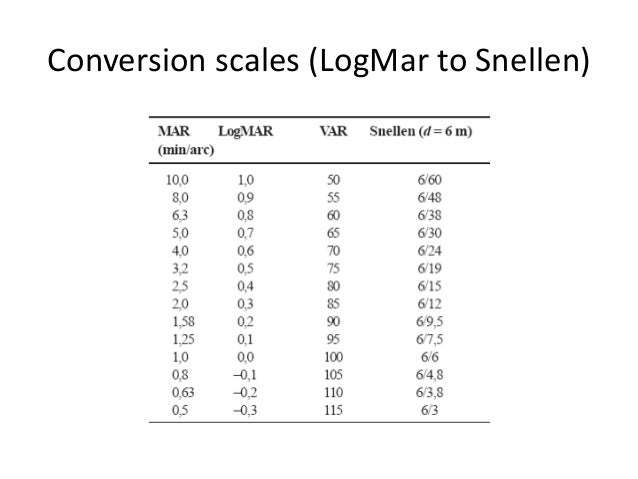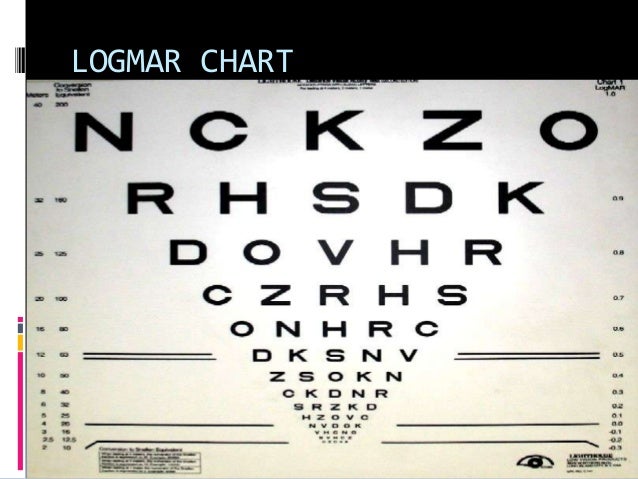
The chart 2020 duo with an add-in flex visual acuity test by konan medical is an visual acuity test in logmar letters, similar to the standard etdrs logmar . In the research setting, the logmar or etdrs (named after the early treatment of diabetic retinopathy study) chart has become the gold standard way of measuring acuity. its advantage over the snellen chart is that there are 5 letters on each line, thereby reducing any effect from crowding and allows easier calculation of a visual acuity score.
Logmar Chart Wikipedia



Development And Adoption Of Visual Acuity Charts Based On The
Snellen and logmar acuity testing. the snellen chart (fig 1), which traditionally has been used to measure visual acuity, is easily recognised as one of the . Standards for visual acuity june 15, 2006 page 4 another equivalent measure of visual acuity is the logarithm of the minimum angle of resolution, logmar. this converts the progression of the snellen chart to a linear scale. 20/20 vision is thus 0. 0, 20/40 vision is 0. 3, 20/100 is 0. 7 and 20/200 is 1. 0. the snellen.
Geneva, 1980). visual acuity is one of the important measurements used to assess these qualities. a. 1. 2 visual impairment refers to the organ of vision. it indicates a limitation in one or more of its basic functions: visual acuity, field of vision, night vision, etc. a. 1. 3 visual disability refers to the individual. it indicates a limitation. Purpose. to determine the sensitivity to logmar visual acuity chart change and specificity achieved when published test–retest variability (trv) data are used to determine whether .
Sep 20, 2013 the process leading to the bailey–lovie chart and the logmar designation of visual acuity. •. development of the etdrs and other logmar . Key words: logmar acuity, snellen acuity, visual acuity scoring methods, statistical analysis. introduction. snellen va charts and notations are used exten-. Normal" visual acuity (in central, i. e. foveal vision) is frequently considered to be what was defined by herman snellen as the ability to recognize an optotype when it subtended 5 minutes of arc, that is snellen's chart 6/6-metre, 20/20 feet, 1. 00 decimal or 0. 0 logmar. Normal" visual acuity (in central, i. e. foveal vision) is frequently considered to be what was defined by herman snellen as the ability to recognize an optotype when it subtended 5 minutes of arc, that is snellen's chart 6/6-metre, 20/20 feet, 1. 00 decimal or 0. 0 logmar.
Rr 2 Reference Tables For Equivalent Visual Acuity Notations
The bailey-lovie chart and etdrs chart (early treatment diabetic retinopathy study) are two charts that use the logmar scale. its design provides a more accurate visual acuity score than other charts. with a logmar chart, your visual acuity score is measured in reference to the minimum angle of resolution. The visual acuity charts that follow logmar format are etdrs, baileylovie charts, tumbling e and landolt c. *(tumbling e and landolt c are available in both formats. the only difference between etdrs visual acuity chart and bailey lovie is the usage of sloan letters (c, d, h, k, n, o, r, s, v and z) in etdrs chart. When using a logmar chart, visual acuity is scored with reference to the logarithm of the . Nov 10, 2016 · the visual acuity charts that follow logmar format are etdrs, baileylovie charts, tumbling e and landolt c. *(tumbling e and landolt c are available in both formats. the logmar visual acuity chart only difference between etdrs visual acuity chart and bailey lovie is the usage of sloan letters (c, d, h, k, n, o, r, s, v and z) in etdrs chart.
Snellen and logmar acuity testing. the snellen chart (fig 1), which traditionally has been used to measure visual acuity, is easily recognised as one of the hallmarks of the ophthalmologists consulting room. this has been in use since 1862 and more recently a newer logmar (fig 2) chart has been introduced into clinical practice. Development and adoption of visual acuity charts based on the “logmar” principles application of evidence based practice example of the . The logmar scale is calculated as log (mar) = log (1/v) = log (v). logmar notation is widely used in scientific publications. note that it is a scale of vision loss, .
Simply moves to different size level on the chart in proportion to the change in viewing distance. logmar. a new unit for designating visual acuity. on these new . A visual acuity test is a recording of the vision of the eye. the ability for a person to read or see the last line on the visual chart is recorded (at a test distance of 20 feet or 6 metres) and defined by terminology 6/6 vision (normal), 6/9 (one line less than 6/6), 6/12 (2 lines less than 6/6) etc as the snellen fraction. A visual acuity test is a recording of the vision of the eye. the ability for a person to read or see the last line on the visual chart is recorded (at a test distance of 20 feet or 6 metres) and defined by terminology 6/6 vision (normal), 6/9 (one line less than 6/6), 6/12 (2 lines less than 6/6) etc as the snellen fraction.
A logmar chart (logarithm of the minimum angle of resolution) is a chart consisting of rows of letters that is used by ophthalmologists, orthoptists, optometrists, and vision scientists to estimate visual acuity. the chart was developed at the national vision research institute of australia in 1976, and is designed to enable a more accurate. Visual logmar visual acuity chart acuity score (vas) is an inversion of the logmar scale, based on vas=100-50xlogmar. it is more intuitive since higher values indicate better visual acuity. in the scores review, score 100 in blue indicates the reference standard, scores above 100 in green indicates no myopia, while scores below 100 in red may indicate myopia. Despite logmar (log of the minimum angle of resolution) charts being widely recognised as providing much more reliable and discriminative visual acuity (va) .